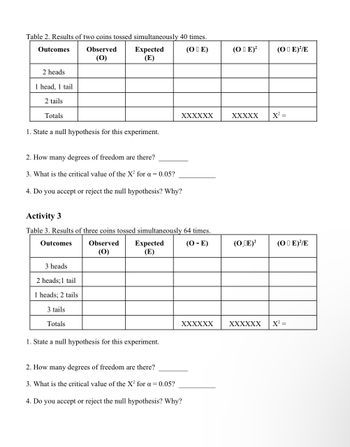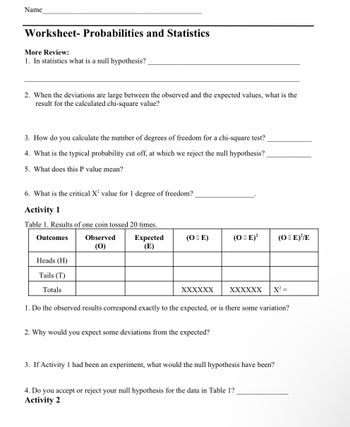
A common way to analyze count or frequency (e.g., number of head or tails) data is with a chi-
square test. The chi-square test is used in all fields of science to determine if there is a difference
between one set of data with observations that are grouped into two or more categories (e.g.,
heads or tails) and the expected number of observations in each category. The null hypothesis
would be that the number of heads and tails are not different than one another (similar numbers
of heads and tails are observed relative to expected). A large Chi-square value relative to the
Chi-square critical value would result in a small p value (p<0.05) and indicate that there were
more heads than tails indicating little support for the null hypothesis.
The formula for calculating a chi-square test is below.
Watch the following video for help: https://youtu.be/PnfpWBduB-A
Activity 1 You will need one coin for this activity.
1. Toss a single coin 20 times, recording the number of times the coin lands on "heads" and
"tails" in the Observed Number (O) column of Table 1 on the Worksheet page.
2. Calculate and record the Expected Number (E) in Table 1. The expected number is always
equal to the probability of the
3. Calculate and record in Table 1 the deviations from the expected; i.e., O E.
Below are two more activities and their respective tables are on the Worksheet page. After
completing the activities, fill in the tables and answer the associated questions.
Activity 2 You will need two coins for this activity.
1. Toss two coins together 40 times, recording the observed combinations in Table 2.
2. Calculate and record the expected number of each combination in Table 2.
3. Calculate and record the deviations from the expected in Table 2.
Activity 3 You will need three coins for this activity.
1. Toss three coins together 64 times and record the observed combinations in Table 3.
2. Calculate and record the expected number of each combination in Table 3.
3. Calculate and record the deviations from the expected in Table 3.


Hello! As you have posted 3 different activities, we are answering the first question. In case you require the unanswered question also, kindly re-post them as separate question.
Activity 1:
In the Activity 1, toss a single coin 20 times, recording the number of times the coin lands on "heads" and
"tails".
P(Head)=P(Tail)=1/2=0.5
1.
Null Hypothesis:
The null hypothesis states that there is no difference in the test, which is denoted by .
Moreover, the sign of null hypothesis may be equal, greater than or equal and less than or equal.
2.
When the deviations are large between the observed and the expected values,
The result for the calculated chi-square value becomes large if the deviations are large between the observed and the expected values.
3.
Number of number degrees of freedom for a chi-square test:
df=number of groups (or categories)-1
4.
Decision Rule:
If p-value ≤ α(=0.05), then reject the null hypothesis.
5.
P value:
The probability of observing the sample statistic is as or more than the observed value by assuming the null hypothesis as true.
6.
degrees of freedom is 1.
let
Chi square critical value is 3.8415, from the excel function, =CHISQ.INV.RT(0.05,1).
Step by stepSolved in 3 steps

- 3arrow_forwardIn a study examining the relation of math ability to the belief that math ability was innate, the belief was considered the predictor variable. The researcher hopes to find a correlation between the participants’ math ability and their belief that math ability is innate. The scores for the three participants are shown below. The group that believed that math is NOT innate scored 66, 70, 50. The group that believed that math IS innate scored 7, 4,10. what are the mean and SD for each group?arrow_forwardTravelers who have no intention of showing up often fail to cancel their hotel reservations in a timely manner. These travelers are known, in the parlance of the hospitality trade, as “no-shows”. To protect against no-shows and late cancellations, hotels invariably overbook rooms. A recent study examined the problems of over-booking rooms in the hotel industry. The following data, extracted from the study represent the daily numbers of late cancellations and no-shows for a random sample of 10 days at a hotel: 18, 16, 16, 16, 14, 18, 16, 18, 14, 19. c) Count the number of measurements that actually fall within the interval(x¯−2s, x¯+2s){ and express the interval count as a percentage of total number of measurementsarrow_forward
- Travelers who have no intention of showing up often fail to cancel their hotel reservations in a timely manner. These travelers are known, in the parlance of the hospitality trade, as “no-shows”. To protect against no-shows and late cancellations, hotels invariably overbook rooms. A recent study examined the problems of over-booking rooms in the hotel industry. The following data, extracted from the study represent the daily numbers of late cancellations and no-shows for a random sample of 10 days at a hotel: 18, 16, 16, 16, 14, 18, 16, 18, 14, 19. a) Compute s, the sample s.d. for the data setarrow_forwardThe Bureau of Labor Statistics reports that the official unemployment rate for Black people was 10.4% and 4.7% for White people in February 2015. Select all correct answers for this question. O The samples of white and black people are independent. The explanatory variable is the unemployment rate. The response variable is the unemployment rate. The response variable is race.arrow_forwardWhich of these scenarios means that a pretest-posttest design with a non-equivalent control group is not suitable? Select all that apply. O a. All of the available participants will be receiving the intervention at the same time. O b. Authors want to examine for any trends in the data over time. O c. The participants were placed into the experimental and control groups by natural circumstances rather than random assignment. O d. Authors want to compare averages between two groups before and after the intervention using an ANOVA.arrow_forward
- Need C and Darrow_forwardJulius has conducted a very small study of the amount of sleep his dorm mates get each night. He believes that those who are on one of the school’s sports teams will get more sleep (measured in hours per night) than those who are not. Julius surveyed 12 people. Of these, 6 played on a sports team and 6 did not. The descriptive statistics from his survey are given below. PLAYS SPORTS (Sample 1) DOES NOT PLAY SPORTS (Sample 2) 8 6 9 6 8 5 7 7 8 7 7 6 What is the critical value for this test? what is the t-obtain value for this t-test? Based on your t-obtained value, what should you conclude about the null hypothesis for this test?arrow_forwardHere is the Statistics problem. Read this passage. What is the explanatory variable in this passage?arrow_forward
- A professor was interested in how exam performance related to study time. Just before an exam began the professor asked students in his class to write down how many hours they had studied for the exam in the past two weeks. He then compared their exam scores to the reported study time. What type of study did the professor carry out? ex post facto correlational case experimentalarrow_forwardDescribe a study in which you can use both nonparametric and parametric statistics. A researcher has participants expecting to receive either painful or mild electrical shocks during a study wait in a quarter-full waiting room with other participants. He then measures whether they choose to sit next to other participants or if they sit far away on their own. What is the best test to run for this study and why?arrow_forward
 MATLAB: An Introduction with ApplicationsStatisticsISBN:9781119256830Author:Amos GilatPublisher:John Wiley & Sons Inc
MATLAB: An Introduction with ApplicationsStatisticsISBN:9781119256830Author:Amos GilatPublisher:John Wiley & Sons Inc Probability and Statistics for Engineering and th...StatisticsISBN:9781305251809Author:Jay L. DevorePublisher:Cengage Learning
Probability and Statistics for Engineering and th...StatisticsISBN:9781305251809Author:Jay L. DevorePublisher:Cengage Learning Statistics for The Behavioral Sciences (MindTap C...StatisticsISBN:9781305504912Author:Frederick J Gravetter, Larry B. WallnauPublisher:Cengage Learning
Statistics for The Behavioral Sciences (MindTap C...StatisticsISBN:9781305504912Author:Frederick J Gravetter, Larry B. WallnauPublisher:Cengage Learning Elementary Statistics: Picturing the World (7th E...StatisticsISBN:9780134683416Author:Ron Larson, Betsy FarberPublisher:PEARSON
Elementary Statistics: Picturing the World (7th E...StatisticsISBN:9780134683416Author:Ron Larson, Betsy FarberPublisher:PEARSON The Basic Practice of StatisticsStatisticsISBN:9781319042578Author:David S. Moore, William I. Notz, Michael A. FlignerPublisher:W. H. Freeman
The Basic Practice of StatisticsStatisticsISBN:9781319042578Author:David S. Moore, William I. Notz, Michael A. FlignerPublisher:W. H. Freeman Introduction to the Practice of StatisticsStatisticsISBN:9781319013387Author:David S. Moore, George P. McCabe, Bruce A. CraigPublisher:W. H. Freeman
Introduction to the Practice of StatisticsStatisticsISBN:9781319013387Author:David S. Moore, George P. McCabe, Bruce A. CraigPublisher:W. H. Freeman





